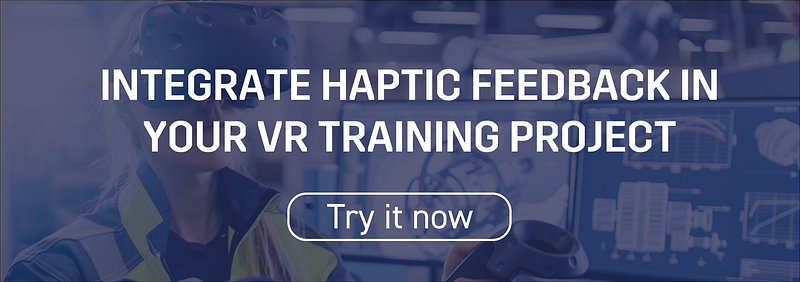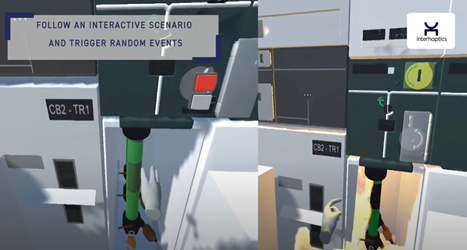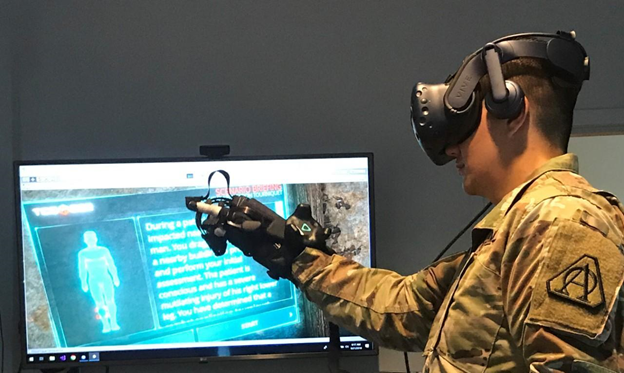This article was extracted from the Recommended Practices for Haptics in Enterprise VR published by the Haptics Industry Forum.
What should be considered while planning to include haptics in a VR training solution?
● Application maturity. A successful virtual training application requires the user company to be familiar with virtual reality technology and to have successfully delivered proof of concepts validating the ROI.
● Developer/Integrator capabilities: The developer and integrator capabilities are important factors to consider while engaging with VR training content creation. VR training applications are well served with great user experiences, refined accessibility, and usability features.

What are the key values to adopt a VR training solution?
● Cost reduction: Reduce real equipment use for training purposes, maintenance cost for training centers, travel cost for trainees.
● Ensure repeatability thanks to the digital format of the learning support.
● Ensure learning consistency thanks to the digital support.
● Increase user retention through increased immersion and gamification techniques.
Why should you include haptics in your VR training solution?
● Skills transfer.Well-designed applications that include haptic feedback in VR training can generate positive learning reinforcement and enhance training effectiveness. This results in a lower error rate during the training process.
● Realism.A similar behavior between the virtual and real environment facilitates skill transfer between the virtual and real case. The absence of natural interaction and realistic haptics can generate bad practices or negative learning that must be unlearned in real-life skill implementation.
● Immersion.Haptics can enhance user immersion during the execution of the training content. User immersion increases the embodiment and believability of the training scenario, increasing its effectiveness.
● User experience.Hand tracking and natural interactions coupled with well-designed haptic feedback can meet or exceed user expectations of interactive content. Interactions can be more precise and realistic, thus reinforcing the sense of presence. This reinforces the “learn by doing” value of VR training. The hand-tracked interaction is transparent and natural, whereas the controller interaction is mediated by a metaphor delivered by the system.
● Ergonomics/usability.VR training is accessible to everyone through the use of hands. The use of haptics reduces the friction of the adoption of VR training content.

Which haptics characteristics should you optimize while designing your content and choosing your haptics device?
● Wearability.Virtual reality training needs to meet operational targets to justify its ROI. The haptics device used for these applications should be easy to wear, comfortable, and should not impede users’ natural movements.
● Embodiment.The ideal haptic device should be transparent while not interacting and perfectly reproduce reality while interacting with VR. System developers should optimize transparency given their budget constraints.
● Scalability (hours of use, number of deployments, etc.). One of the key aspects to consider when thinking about haptics in VR is the origin of scalability. Do you need repeatability of the same content on different premises, to target hundreds if not thousands of users? Or are you looking to create a one-of-a-kind setup for critical operation training for specific applications? Both scenarios have different needs and requirements that can be addressed by different haptic devices.
● Skills training: hard or soft? Are you planning to teach how to use a simple HMI system? To ease the use of a soft skill training scenario, or to train how to precisely mount an aircraft? These use cases require different levels of haptics starting from optical hand tracking towards a high-fidelity hand haptics device.
● Integration of non-haptic peripherals. Increase the fidelity of the training by passive haptics with real objects “dummy objects” with haptic feedback from the device.
● Content enablement.The implementation of haptics in existing content requires the specification of the haptics experience to be created. This can be delivered by purchasing existing haptics assets to be combined into the scenario using haptics design software to create the necessary content. Or delivering specialized haptics development with the support of a service provider.
Overview of VR training use cases
VR training (VRT) defines a solution using virtual or mixed reality to transfer useful skills to the trainee, by using an extended reality solution.
Ranging from electrical maintenance training operations to automotive assembly training, automotive painting training, satellite assembly training, and realistic first aid training. The role of haptics is focused on accessibility and skill transfer. The outcome is usually positive, and these use cases are in use today.
Use case 1: A well-known electrical equipment provider regularly commercializes low and medium-voltage electrical equipment needing maintenance. The customer’s workforce needs to perform scheduled training to learn and refresh the procedures to perform the maintenance operations. This training is performed at training centers around the globe. The sessions are extremely expensive, involving the workforce traveling to the training center, a few days stay to perform training activities on dummy machines under the trainer’s supervision. The electrical equipment manufacturer developed a haptics training solution to digitize the maintenance and security training for the workforce to bring the training sessions to the customer. The solution also commercializes a VR training system, including haptics and VR equipment, to allow their customer to keep the training scenarios and experience as documentation.

Customer Goals: Risk reduction, skill transfer, reduced costs, increased margins.
Haptic Technologies Used: The system was developed in Unity and incorporated 4 VR Touch (Go Touch VR) gloves. These gloves provide skin indentation feedback to enable tactile sensations primarily related to grasping and manipulation.
Role of Haptics: Haptics was added to the simulation to increase usability and skills transfer. It was initially challenging to communicate this value to the customer. Once the customer understood that haptics does not reproduce reality with perfect fidelity, it became easier to have a pragmatic discussion about the correct use of haptic feedback in the simulation.
Outcome: After two years, the customer is still using the project. The enhanced usability created with haptic feedback is a key reason for the lasting success of this use case.
Use case 2: VR-based training application for automotive painting. A range of vibrations was introduced to guide the user through the painting processes, errors, and the set of guidelines. If the applied pressure is high, the user gets particular feedback. If the applied pressure is low, the user gets the appropriate feedback. An entire set of feedback is utilized for different sections of the training guidelines.

Customer Goals: Risk reduction, skill transfer, product/experience insights.
Haptic Technologies Used: The type of haptic feedback used for the project was based on vibrotactile perception. Essentially, the actuators were Actronika’s patented voice-coil motors (Hapcoil One) with a resonant frequency of 65 Hz. The VCAs were driven by our embedded solutions which is essentially a software-based control (Unitouch Embedded). The vibrations used were part of our library of UI effects.
Role of Haptics: Immersion, usability, user experience.
Outcome: The product is in use by the customer who is ordering parts every quarter. It is listed as one of the most satisfied customers.
Use case 3: SenseGlove Nova has been implemented in the military VR training for assembling a satellite receiver. The aim is to avoid damaging expensive training equipment. Using haptics gloves in a virtual environment, the trainees are able to install the virtual parts of the satellite receiver in a similar way as they would install the real equipment.

Customer Goals: Skill transfer, reduced development costs.
Haptic Technologies Used: The SenseGlove Nova force and haptic feedback gloves. A multiplayer game based on the Unity engine and in integration solution of VREE, a Dutch VR development agency.
Role of Haptics: Realism, immersion, user experience.
Outcome: The study is not finished yet after 4 months of activity, but the first results are positive. There need to be some tweaks, but it has a high chance of becoming the standard way of interaction for this training of the Dutch defense.
Use case 4: Volkswagen and SenseGlove have created a virtual reality assembly training of the electric components within the sliding door of the T6 van. In this scenario, participants are able to train the full procedure of all actions in this particular assembly process.

Customer Goals: Skill transfer, reduced development costs.
Haptic Technologies Used: SenseGlove DK1. A CAD to Unity pipeline. And the Unity game engine to create the content.
Role of Haptics: Skills transfer, realism, immersion, usability.
Outcome: The project satisfied the objective as a research project. For the desired implementation, a new follow-up project is needed with improved usability. This specific project lasted for 4 months and is finished. A follow-up project is scheduled for 2021.
Use case 5: In 2020, the United States Defense Health Agency awarded a contract to HaptX and others to develop a haptics-based training system to improve the skills of U.S. Army fighters who administer emergency trauma care on the battlefield. The contract funded HaptX and its partners Engineering & Computer Simulations and Mayo Clinic to integrate the true-contact haptics of HaptX Gloves with the Army’s Tactical Casualty Combat Care (TC3) environment. For many years, TC3 used VR to teach soldiers to perform airway management, access vascular systems, apply tourniquets, and more. But without realistic touch feedback, trainees were only able to learn abstract procedural steps and were unable to naturally practice key skills and physical interactions. This contract funded research and development to improve the quality and retention of training with the goal of saving more lives on the battlefield.

Customer Goals: Skills transfer, increased training effectiveness.
Haptic Technologies Used: The project incorporated multiple HaptX Gloves DK2 systems. These gloves maximize realism by combining high-fidelity tactile feedback which displaces skin up to 2 mm, variable force feedback delivering up to 40lbs of resistive force per hand, and electromagnetic finger tracking.
Role of Haptics: The developers of this project applied haptic effects to the virtual interactions to enable trainees to physically feel and practice the training program’s dexterous manual motions. These interactions included grasping and using supplies, feeling correct locations on the patient’s body, turning the patient’s body, and more. Haptics enabled the developers to achieve the project’s core mission of advancing training through improved manual interfacing with the environment.
Outcome: The Army is midway through the project and will report its findings upon completion. Initial feedback has been positive.
Who is Interhaptics?
Interhaptics is a software company specialized in haptics. Interhaptics provides hand interactions and haptic feedback development and deployment tools for virtual reality (VR), mixed reality (MR), mobile, augmented reality (AR), and console applications. Interhaptics’ mission is to enable the growth of a scalable haptics ecosystem. Interhaptics strives to deliver top-notch development tools for the VR/MR/AR, mobile, and console developer community, and the interoperability of haptics-enabled content across any haptics-enabled platform.

If you are interested in designing high-fidelity haptics or integrating haptic feedback to your virtual reality (VR) project, download Interhaptics Haptics for VR and MR. To collaborate with Interhaptics on your AR/VR/MR project, you can contact us here.






